Robby T. Tan
Rethinking Human-Object Interaction Evaluation for both Vision-Language Models and HOI-Specific Methods
Aug 26, 2025Abstract:Prior human-object interaction (HOI) detection methods have integrated early vision-language models (VLMs) such as CLIP, but only as supporting components within their frameworks. In contrast, recent advances in large, generative VLMs suggest that these models may already possess strong ability to understand images involving HOI. This naturally raises an important question: can general-purpose standalone VLMs effectively solve HOI detection, and how do they compare with specialized HOI methods? Answering this requires a benchmark that can accommodate both paradigms. However, existing HOI benchmarks such as HICO-DET were developed before the emergence of modern VLMs, and their evaluation protocols require exact matches to annotated HOI classes. This is poorly aligned with the generative nature of VLMs, which often yield multiple valid interpretations in ambiguous cases. For example, a static image may capture a person mid-motion with a frisbee, which can plausibly be interpreted as either "throwing" or "catching". When only "catching" is annotated, the other, though equally plausible for the image, is marked incorrect when exact matching is used. As a result, correct predictions might be penalized, affecting both VLMs and HOI-specific methods. To avoid penalizing valid predictions, we introduce a new benchmark that reformulates HOI detection as a multiple-answer multiple-choice task, where each question includes only ground-truth positive options and a curated set of negatives that are constructed to reduce ambiguity (e.g., when "catching" is annotated, "throwing" is not selected as a negative to avoid penalizing valid predictions). The proposed evaluation protocol is the first of its kind for both VLMs and HOI methods, enabling direct comparison and offering new insight into the current state of progress in HOI understanding.
Bridging Annotation Gaps: Transferring Labels to Align Object Detection Datasets
Jun 06, 2025Abstract:Combining multiple object detection datasets offers a path to improved generalisation but is hindered by inconsistencies in class semantics and bounding box annotations. Some methods to address this assume shared label taxonomies and address only spatial inconsistencies; others require manual relabelling, or produce a unified label space, which may be unsuitable when a fixed target label space is required. We propose Label-Aligned Transfer (LAT), a label transfer framework that systematically projects annotations from diverse source datasets into the label space of a target dataset. LAT begins by training dataset-specific detectors to generate pseudo-labels, which are then combined with ground-truth annotations via a Privileged Proposal Generator (PPG) that replaces the region proposal network in two-stage detectors. To further refine region features, a Semantic Feature Fusion (SFF) module injects class-aware context and features from overlapping proposals using a confidence-weighted attention mechanism. This pipeline preserves dataset-specific annotation granularity while enabling many-to-one label space transfer across heterogeneous datasets, resulting in a semantically and spatially aligned representation suitable for training a downstream detector. LAT thus jointly addresses both class-level misalignments and bounding box inconsistencies without relying on shared label spaces or manual annotations. Across multiple benchmarks, LAT demonstrates consistent improvements in target-domain detection performance, achieving gains of up to +4.8AP over semi-supervised baselines.
NTIRE 2025 Challenge on Day and Night Raindrop Removal for Dual-Focused Images: Methods and Results
Apr 19, 2025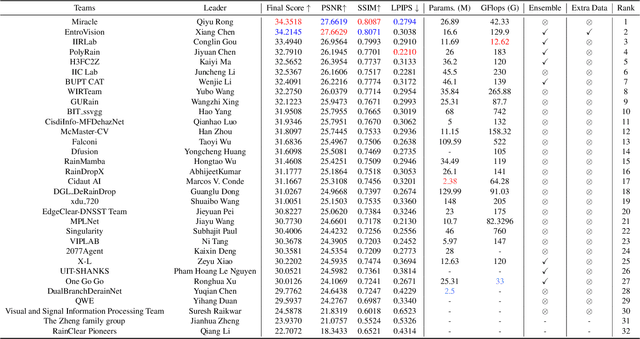
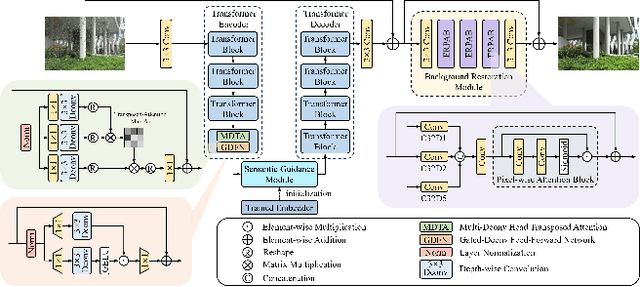
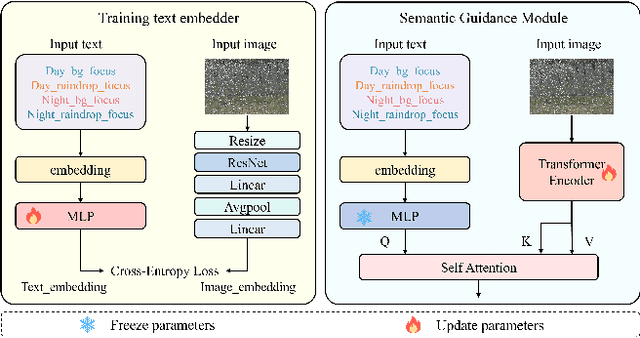
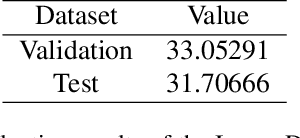
Abstract:This paper reviews the NTIRE 2025 Challenge on Day and Night Raindrop Removal for Dual-Focused Images. This challenge received a wide range of impressive solutions, which are developed and evaluated using our collected real-world Raindrop Clarity dataset. Unlike existing deraining datasets, our Raindrop Clarity dataset is more diverse and challenging in degradation types and contents, which includes day raindrop-focused, day background-focused, night raindrop-focused, and night background-focused degradations. This dataset is divided into three subsets for competition: 14,139 images for training, 240 images for validation, and 731 images for testing. The primary objective of this challenge is to establish a new and powerful benchmark for the task of removing raindrops under varying lighting and focus conditions. There are a total of 361 participants in the competition, and 32 teams submitting valid solutions and fact sheets for the final testing phase. These submissions achieved state-of-the-art (SOTA) performance on the Raindrop Clarity dataset. The project can be found at https://lixinustc.github.io/CVPR-NTIRE2025-RainDrop-Competition.github.io/.
Mamba as a Bridge: Where Vision Foundation Models Meet Vision Language Models for Domain-Generalized Semantic Segmentation
Apr 04, 2025Abstract:Vision Foundation Models (VFMs) and Vision-Language Models (VLMs) have gained traction in Domain Generalized Semantic Segmentation (DGSS) due to their strong generalization capabilities. However, existing DGSS methods often rely exclusively on either VFMs or VLMs, overlooking their complementary strengths. VFMs (e.g., DINOv2) excel at capturing fine-grained features, while VLMs (e.g., CLIP) provide robust text alignment but struggle with coarse granularity. Despite their complementary strengths, effectively integrating VFMs and VLMs with attention mechanisms is challenging, as the increased patch tokens complicate long-sequence modeling. To address this, we propose MFuser, a novel Mamba-based fusion framework that efficiently combines the strengths of VFMs and VLMs while maintaining linear scalability in sequence length. MFuser consists of two key components: MVFuser, which acts as a co-adapter to jointly fine-tune the two models by capturing both sequential and spatial dynamics; and MTEnhancer, a hybrid attention-Mamba module that refines text embeddings by incorporating image priors. Our approach achieves precise feature locality and strong text alignment without incurring significant computational overhead. Extensive experiments demonstrate that MFuser significantly outperforms state-of-the-art DGSS methods, achieving 68.20 mIoU on synthetic-to-real and 71.87 mIoU on real-to-real benchmarks. The code is available at https://github.com/devinxzhang/MFuser.
Synthetic-to-Real Self-supervised Robust Depth Estimation via Learning with Motion and Structure Priors
Mar 26, 2025Abstract:Self-supervised depth estimation from monocular cameras in diverse outdoor conditions, such as daytime, rain, and nighttime, is challenging due to the difficulty of learning universal representations and the severe lack of labeled real-world adverse data. Previous methods either rely on synthetic inputs and pseudo-depth labels or directly apply daytime strategies to adverse conditions, resulting in suboptimal results. In this paper, we present the first synthetic-to-real robust depth estimation framework, incorporating motion and structure priors to capture real-world knowledge effectively. In the synthetic adaptation, we transfer motion-structure knowledge inside cost volumes for better robust representation, using a frozen daytime model to train a depth estimator in synthetic adverse conditions. In the innovative real adaptation, which targets to fix synthetic-real gaps, models trained earlier identify the weather-insensitive regions with a designed consistency-reweighting strategy to emphasize valid pseudo-labels. We introduce a new regularization by gathering explicit depth distributions to constrain the model when facing real-world data. Experiments show that our method outperforms the state-of-the-art across diverse conditions in multi-frame and single-frame evaluations. We achieve improvements of 7.5% and 4.3% in AbsRel and RMSE on average for nuScenes and Robotcar datasets (daytime, nighttime, rain). In zero-shot evaluation of DrivingStereo (rain, fog), our method generalizes better than the previous ones.
3DSwapping: Texture Swapping For 3D Object From Single Reference Image
Mar 24, 2025Abstract:3D texture swapping allows for the customization of 3D object textures, enabling efficient and versatile visual transformations in 3D editing. While no dedicated method exists, adapted 2D editing and text-driven 3D editing approaches can serve this purpose. However, 2D editing requires frame-by-frame manipulation, causing inconsistencies across views, while text-driven 3D editing struggles to preserve texture characteristics from reference images. To tackle these challenges, we introduce 3DSwapping, a 3D texture swapping method that integrates: 1) progressive generation, 2) view-consistency gradient guidance, and 3) prompt-tuned gradient guidance. To ensure view consistency, our progressive generation process starts by editing a single reference image and gradually propagates the edits to adjacent views. Our view-consistency gradient guidance further reinforces consistency by conditioning the generation model on feature differences between consistent and inconsistent outputs. To preserve texture characteristics, we introduce prompt-tuning-based gradient guidance, which learns a token that precisely captures the difference between the reference image and the 3D object. This token then guides the editing process, ensuring more consistent texture preservation across views. Overall, 3DSwapping integrates these novel strategies to achieve higher-fidelity texture transfer while preserving structural coherence across multiple viewpoints. Extensive qualitative and quantitative evaluations confirm that our three novel components enable convincing and effective 2D texture swapping for 3D objects. Code will be available upon acceptance.
EZ-HOI: VLM Adaptation via Guided Prompt Learning for Zero-Shot HOI Detection
Oct 31, 2024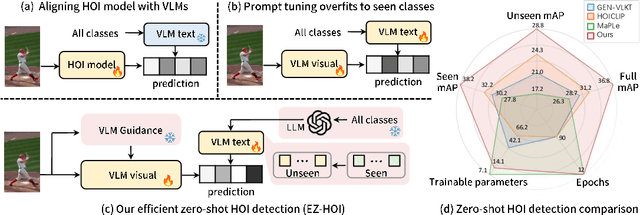

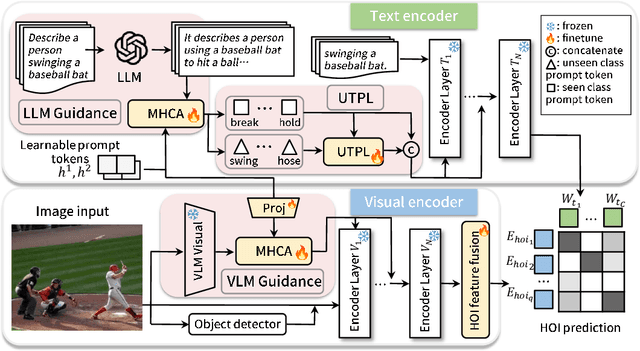

Abstract:Detecting Human-Object Interactions (HOI) in zero-shot settings, where models must handle unseen classes, poses significant challenges. Existing methods that rely on aligning visual encoders with large Vision-Language Models (VLMs) to tap into the extensive knowledge of VLMs, require large, computationally expensive models and encounter training difficulties. Adapting VLMs with prompt learning offers an alternative to direct alignment. However, fine-tuning on task-specific datasets often leads to overfitting to seen classes and suboptimal performance on unseen classes, due to the absence of unseen class labels. To address these challenges, we introduce a novel prompt learning-based framework for Efficient Zero-Shot HOI detection (EZ-HOI). First, we introduce Large Language Model (LLM) and VLM guidance for learnable prompts, integrating detailed HOI descriptions and visual semantics to adapt VLMs to HOI tasks. However, because training datasets contain seen-class labels alone, fine-tuning VLMs on such datasets tends to optimize learnable prompts for seen classes instead of unseen ones. Therefore, we design prompt learning for unseen classes using information from related seen classes, with LLMs utilized to highlight the differences between unseen and related seen classes. Quantitative evaluations on benchmark datasets demonstrate that our EZ-HOI achieves state-of-the-art performance across various zero-shot settings with only 10.35% to 33.95% of the trainable parameters compared to existing methods. Code is available at https://github.com/ChelsieLei/EZ-HOI.
VoiceBench: Benchmarking LLM-Based Voice Assistants
Oct 22, 2024

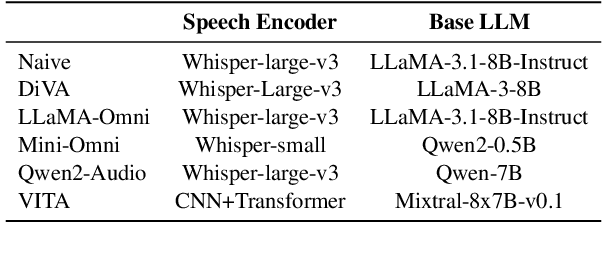
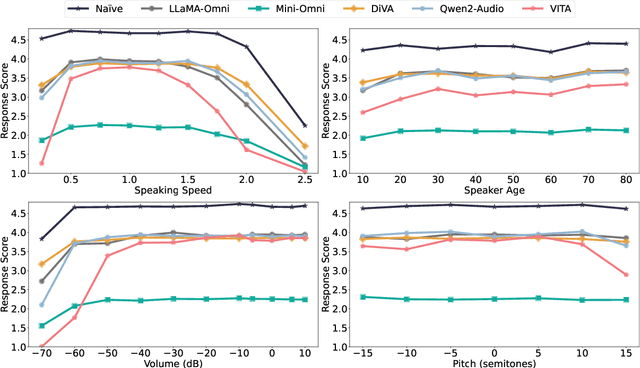
Abstract:Building on the success of large language models (LLMs), recent advancements such as GPT-4o have enabled real-time speech interactions through LLM-based voice assistants, offering a significantly improved user experience compared to traditional text-based interactions. However, the absence of benchmarks designed to evaluate these speech interaction capabilities has hindered progress of LLM-based voice assistants development. Current evaluations focus primarily on automatic speech recognition (ASR) or general knowledge evaluation with clean speeches, neglecting the more intricate, real-world scenarios that involve diverse speaker characteristics, environmental and content factors. To address this, we introduce VoiceBench, the first benchmark designed to provide a multi-faceted evaluation of LLM-based voice assistants. VoiceBench also includes both real and synthetic spoken instructions that incorporate the above three key real-world variations. Extensive experiments reveal the limitations of current LLM-based voice assistant models and offer valuable insights for future research and development in this field.
Representation Learning of Structured Data for Medical Foundation Models
Oct 17, 2024


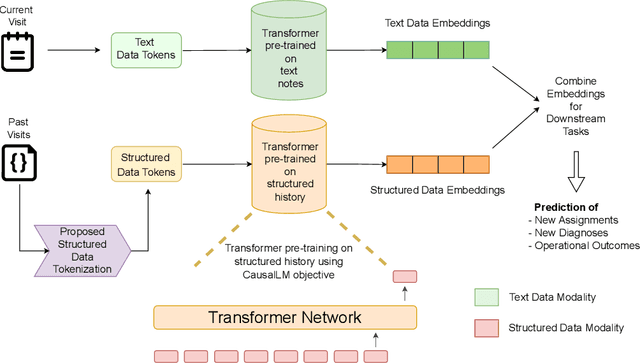
Abstract:Large Language Models (LLMs) have demonstrated remarkable performance across various domains, including healthcare. However, their ability to effectively represent structured non-textual data, such as the alphanumeric medical codes used in records like ICD-10 or SNOMED-CT, is limited and has been particularly exposed in recent research. This paper examines the challenges LLMs face in processing medical codes due to the shortcomings of current tokenization methods. As a result, we introduce the UniStruct architecture to design a multimodal medical foundation model of unstructured text and structured data, which addresses these challenges by adapting subword tokenization techniques specifically for the structured medical codes. Our approach is validated through model pre-training on both an extensive internal medical database and a public repository of structured medical records. Trained on over 1 billion tokens on the internal medical database, the proposed model achieves up to a 23% improvement in evaluation metrics, with around 2% gain attributed to our proposed tokenization. Additionally, when evaluated on the EHRSHOT public benchmark with a 1/1000 fraction of the pre-training data, the UniStruct model improves performance on over 42% of the downstream tasks. Our approach not only enhances the representation and generalization capabilities of patient-centric models but also bridges a critical gap in representation learning models' ability to handle complex structured medical data, alongside unstructured text.
Beyond Single-Audio: Advancing Multi-Audio Processing in Audio Large Language Models
Sep 27, 2024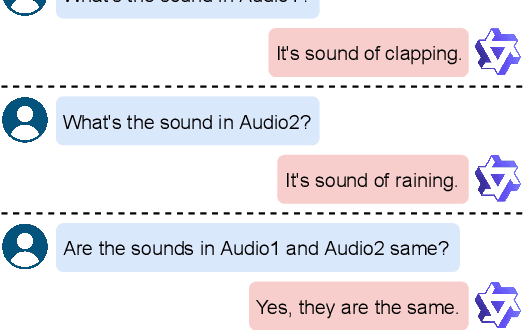
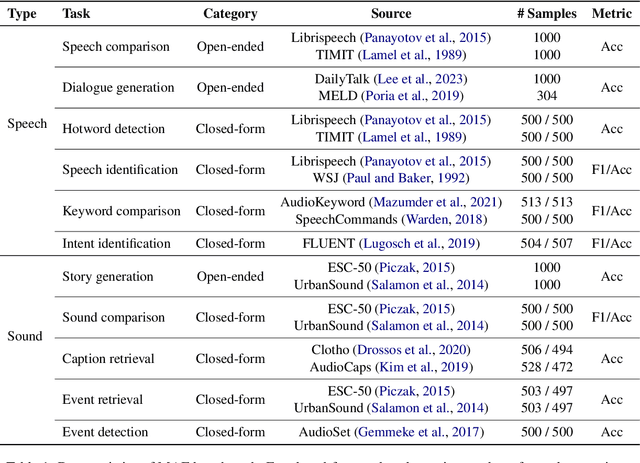
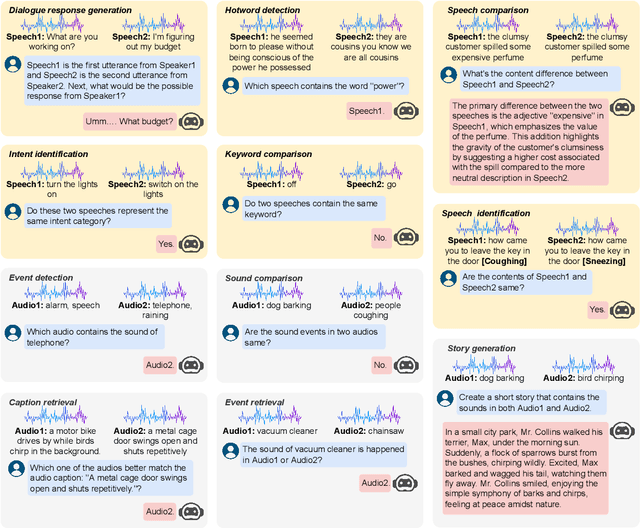
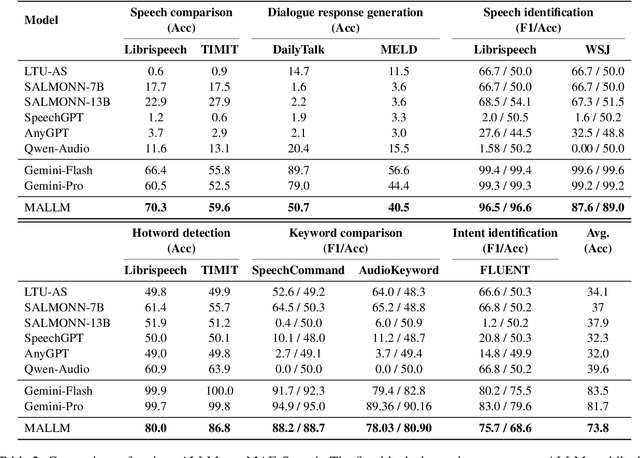
Abstract:Various audio-LLMs (ALLMs) have been explored recently for tackling different audio tasks simultaneously using a single, unified model. While existing evaluations of ALLMs primarily focus on single-audio tasks, real-world applications often involve processing multiple audio streams simultaneously. To bridge this gap, we propose the first multi-audio evaluation (MAE) benchmark that consists of 20 datasets from 11 multi-audio tasks encompassing both speech and sound scenarios. Comprehensive experiments on MAE demonstrate that the existing ALLMs, while being powerful in comprehending primary audio elements in individual audio inputs, struggling to handle multi-audio scenarios. To this end, we propose a novel multi-audio-LLM (MALLM) to capture audio context among multiple similar audios using discriminative learning on our proposed synthetic data. The results demonstrate that the proposed MALLM outperforms all baselines and achieves high data efficiency using synthetic data without requiring human annotations. The proposed MALLM opens the door for ALLMs towards multi-audio processing era and brings us closer to replicating human auditory capabilities in machines.
 Add to Chrome
Add to Chrome Add to Firefox
Add to Firefox Add to Edge
Add to Edge